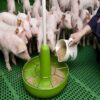A butcher shop is a specialized shop that sells different cuts of meat from different animals. Butcher shops typically sell poultry, beef, pork, lamb and seafood. The meat sold can be raw, semi-cooked, or ready-to-eat. They sell to the general public, rather than to restaurants or other retail establishments.
Butchers usually purchase larger portions of meat or cuts of animals and then cut, chop, or grind these down into smaller portions. They then sell this meat to the general public, usually charging by the kilogram (kg) or by the portion.
A butcher shop usually sells different cuts of the same animal. For example, they will sell multiple cuts of steak, such as ribeye, sirloin, and tenderloin. Some butchers also sell other food products such as bread and other baked goods and sauces or marinades to accompany the meat.
Although butchers do not require a formal education, to open a butcher shop, you will need to be highly trained and experienced. This is because you will be dealing with potentially dangerous equipment and high-risk food items. You will also need a strong knowledge of food safety and hygiene and an understanding of all the relevant laws and regulations you will need to follow.
To start a butcher shop you have to be safety conscious, have great hand-eye coordination, and be passionate about providing high-quality meat. You also need to have strong personal skills to communicate with vendors and customers and good business and organizational skills.
Many of the customers who visit your butcher shop will be people who live in the local area. Butcher shops often rely on foot traffic so being located in the center of a village, town, or city can be beneficial. Alternatively, a residential location could also give you access to a large number of customers.
Because butcher shops can be more expensive than supermarkets, typically, butcher shops receive most of their business from customers who are happy to spend a little more money on higher-quality meat products. You may also receive business from customers who want to know where the meat comes from and want to shop locally and support local businesses.
Butcher shops usually have customers who visit them regularly. Your customers may also recommend your shop to their friends and family, helping to support your business. As well as customers who visit your shop, you could also increase your profits by supplying meat to events. This is a great way to attract customers as you can supply a large amount of meat at one time.
Read Also: Exploring the Benefits of Motor Finance
What Do You Need to Start a Butcher Shop?

1. A Feasibility Report: Conducting a feasibility report is crucial to determine if your butcher shop idea is viable. This report should include an analysis of the market demand in your area, the level of competition, and the preferences of your potential customers. Investigate the local population’s meat consumption habits and their preferences for specific types of meat.
Also, analyze your competitors by examining how many butcher shops are in the area, what products and services they offer, and their pricing strategies. Additionally, financial projections should be part of this report to estimate potential revenue and expenses, helping you understand if the business can be profitable.
2. Business and Marketing Plans: A comprehensive business plan serves as a roadmap for your butcher shop. It should outline your business goals, strategies, and operational plans. Include an executive summary, a description of your business, and a detailed market analysis.
Explain your organization and management structure, describe your product line, and develop a marketing and sales strategy. If you need financing, specify how much you need and how you will use the funds. Include financial projections that forecast revenue, expenses, and profits for at least the first three years.
Your marketing plan should focus on how you will reach your target market. Develop a strong brand identity, utilize online and offline advertising channels, and create customer engagement strategies such as loyalty programs and special promotions.
3. Business Licenses and Permits: To operate legally, obtain the necessary business licenses and permits. These vary by location but generally include a business license, health permits, food handling permits, and zoning permits.
The business license allows you to legally run your business, while health and food handling permits ensure your shop meets local health and safety standards. Zoning permits confirm that your location is zoned for a butcher shop. Check with local, state, and federal authorities to ensure you have all the required permits.
4. Shop Facility: Finding the right location is vital for your butcher shop’s success. Look for a space with enough room for meat processing, storage, and customer areas. Ensure your shop is easily visible and accessible to attract customers.
The facility must meet all local health and safety regulations, including proper ventilation, refrigeration, and sanitation. Adequate space is essential for meat processing, storage, and display, allowing for smooth operation and an inviting environment for customers.
5. EIN (Employer Identification Number)/Federal Tax ID Number: An Employer Identification Number (EIN) is required for tax purposes and is necessary if you plan to hire employees. You can obtain an EIN from the IRS. This number is also needed when opening a business bank account and filing taxes. It helps the IRS track your business’s tax obligations and ensures you comply with federal regulations.
6. A Corporate Bank Account: Separating your personal and business finances is crucial for effective financial management. Open a corporate bank account to handle all your business transactions. This account will help you track income and expenses, making it easier to manage cash flow and maintain transparency. A dedicated business account also simplifies tax filing and ensures your personal assets are protected.
7. Equipment, Machines, and Supplies: Investing in the right equipment is essential for running a butcher shop efficiently and safely. Basic equipment includes meat processing machines such as slicers, grinders, and saws. Refrigeration units are necessary for storing meat at the correct temperatures to maintain freshness and safety.
Display cases are needed to showcase your products to customers. Additionally, invest in high-quality cutting tools, packaging materials, and safety equipment such as gloves, aprons, and first-aid kits. Ensure you buy durable, high-quality equipment to maintain product quality and safety.
8. Employees: Hiring skilled employees is important for the success of your butcher shop. Look for staff with experience in meat cutting and handling, and provide thorough training to ensure they adhere to health and safety regulations.
Good customer service skills are also crucial, as friendly, knowledgeable staff can enhance the customer experience and build loyalty. Employees who can offer cooking advice, recommend cuts, and provide excellent service can set your shop apart from the competition.
9. Startup and Working Capital: Starting a butcher shop requires significant investment. You will need startup capital to cover initial costs such as leasing or purchasing a facility, buying equipment and supplies, stocking inventory, and funding marketing efforts to attract customers. Additionally, you need funds for licenses and permits.
Working capital is essential to cover ongoing operational expenses until the business becomes profitable. This includes employee wages, utility bills, and the ongoing purchase of packaging materials and other consumables. Regular maintenance of equipment and facilities is also necessary to ensure smooth operations.
Read Also: How to Start a CJ Dropshipping Business
How Much Does It Cost to Start a Butcher Shop?

Starting a butcher shop involves several costs that you need to consider carefully. The total cost will depend on various factors, including the location, the size of the shop, and the quality of the equipment and supplies you choose. Here is an overview of what to expect financially when opening a butcher shop.
First, you need to think about the feasibility study and market research. This initial step is essential to understand the market demand, competition, and customer preferences in your chosen location. Hiring a consultant or conducting this research yourself will incur some costs, but it is a crucial investment to ensure your business idea is viable.
Next, there is the business plan. While creating a business plan does not have a direct cost if you do it yourself, hiring a professional to help you develop a comprehensive plan can range from a few hundred to several thousand dollars. This plan is vital for outlining your business goals, strategies, and financial projections, and it is often required if you seek financing from banks or investors.
Securing a suitable location for your butcher shop is one of the most significant expenses. The cost of renting or purchasing a commercial space varies widely based on the area. Prime locations with high foot traffic can be more expensive but may attract more customers.
Leasing a space typically involves paying a security deposit and the first month’s rent upfront, which can add up quickly. If you decide to buy a property, you will need to consider the down payment and mortgage costs. Renovating and setting up the shop facility to meet health and safety standards is another substantial expense.
This includes installing proper refrigeration systems, ventilation, flooring, and sanitation facilities. The cost of renovations can vary greatly depending on the condition of the space and the extent of the modifications needed. Additionally, you will need to purchase display cases and storage units to keep your products fresh and appealing to customers.
Obtaining the necessary licenses and permits to operate legally is another cost to consider. These include a business license, health permits, food handling permits, and zoning permits. The fees for these licenses and permits can vary depending on your location. It is essential to research the specific requirements in your area and budget for these expenses accordingly.
You will also need an Employer Identification Number (EIN) from the IRS, which is free to obtain, but you may need to pay for professional help if you are not comfortable navigating the application process yourself. This number is necessary for tax purposes and if you plan to hire employees.
Opening a corporate bank account is crucial for managing your finances, and while the cost is minimal, you should still account for any initial deposit requirements or monthly fees the bank might charge. Keeping your personal and business finances separate is essential for clear financial management and legal protection.
The cost of equipment, machines, and supplies is another major consideration. You will need meat processing machines like slicers, grinders, and saws, which can be quite expensive. High-quality refrigeration units are essential for keeping your products fresh, and these can also be costly.
Other necessary items include cutting tools, packaging materials, and safety equipment such as gloves and aprons. Investing in durable, high-quality equipment is important to ensure efficiency and safety in your operations. Hiring skilled employees is another significant cost.
You will need to budget for wages, benefits, and training for your staff. Experienced butchers typically command higher salaries, but their expertise can greatly contribute to the success of your shop. Additionally, you should consider the cost of uniforms and any ongoing training programs to keep your staff up-to-date with the latest food safety regulations and techniques.
Marketing and advertising are crucial for attracting customers to your new butcher shop. Creating a strong brand identity and promoting your shop through various channels can be costly. This might include designing a logo, creating a website, printing business cards and flyers, and running advertisements in local newspapers or on social media. Effective marketing can help you build a loyal customer base and generate steady revenue.
Finally, you need to consider the working capital required to keep your business running smoothly until it becomes profitable. This includes covering ongoing expenses such as rent, utilities, employee wages, and inventory. It is advisable to have enough working capital to sustain your operations for at least six months to a year, as it may take time to build a steady customer base and achieve profitability.
Steps on How to Start a Butcher Shop

Step 1: Conduct a Feasibility Study: Before you begin, conduct a feasibility study to understand the market demand, competition, and customer preferences in your chosen location. Research the local population’s meat consumption habits, identify competitors, and analyze their strengths and weaknesses. This study will help you determine if your butcher shop idea is viable and what niche you can fill in the market.
Step 2: Develop a Business Plan: A comprehensive business plan is essential for outlining your business goals, strategies, and financial projections. Your business plan should include an executive summary, business description, market analysis, organizational structure, product line, marketing strategy, and financial forecasts. A well-thought-out business plan will guide your operations and is often required when seeking financing from banks or investors.
Step 3: Secure Financing: Starting a butcher shop requires a significant investment. Calculate the startup costs, including equipment, renovations, initial inventory, and working capital. Determine how much funding you need and explore different financing options, such as personal savings, bank loans, or investors. Present your business plan to potential lenders or investors to secure the necessary funds.
Step 4: Obtain Licenses and Permits: To operate legally, you will need to obtain various licenses and permits. These may include a business license, health permits, food handling permits, and zoning permits. Check with local, state, and federal authorities to understand the specific requirements in your area and apply for the necessary documents. Ensuring you have all required licenses and permits will help you avoid legal issues down the line.
Step 5: Find a Suitable Location: Choosing the right location is crucial for the success of your butcher shop. Look for a space that is easily accessible and visible to attract customers. Consider factors like foot traffic, parking availability, and proximity to residential areas or complementary businesses. The facility should have enough space for meat processing, storage, and customer areas, and it must meet local health and safety regulations.
Step 6: Design and Renovate the Shop: Once you have secured a location, design and renovate the shop to meet health and safety standards. This includes installing proper refrigeration systems, ventilation, flooring, and sanitation facilities. Create an efficient layout that allows for smooth operations and an inviting environment for customers. Ensure that the shop complies with all local health and safety regulations.
Step 7: Purchase Equipment and Supplies: Investing in high-quality equipment is essential for running a butcher shop efficiently and safely. Purchase meat processing machines like slicers, grinders, and saws, as well as refrigeration units for storing meat at the correct temperatures. You will also need display cases, cutting tools, packaging materials, and safety equipment such as gloves, aprons, and first-aid kits. Ensure all equipment is durable and meets industry standards.
Step 8: Hire and Train Employees: Hiring skilled employees is vital for the success of your butcher shop. Look for staff with experience in meat cutting and handling. Provide thorough training to ensure they adhere to health and safety regulations and deliver excellent customer service. Employees should be knowledgeable about different cuts of meat and able to offer cooking advice and recommendations to customers.
Step 9: Develop a Marketing Strategy: A strong marketing strategy is crucial for attracting customers to your butcher shop. Develop a brand identity that sets your shop apart from competitors. Create a website, use social media, and consider local advertising options like newspapers and flyers. Offering promotions, loyalty programs, and special events can also help draw in customers and build a loyal customer base.
Step 10: Set Up a Business Bank Account: Open a business bank account to manage your finances. This helps keep your personal and business finances separate, making it easier to track income and expenses and ensuring clear financial management. A dedicated business account also simplifies tax filing and provides legal protection for your personal assets.
Step 11: Purchase Initial Inventory: Stock your shop with a variety of high-quality meats and related products. Establish relationships with reliable suppliers to ensure a steady supply of fresh products. Offering specialty cuts, marinated meats, and value-added products like sausages can help attract a diverse customer base.
Step 12: Implement Financial Management Systems: Implement financial management systems to keep track of your income and expenses. Use accounting software to monitor cash flow, manage inventory, and generate financial reports. Regularly review your financial statements to ensure your business is on track and make adjustments as needed.
Step 13: Open Your Butcher Shop: Once everything is in place, it is time to open your butcher shop. Host a grand opening event to attract customers and create buzz around your new business. Offer special promotions and samples to encourage people to visit your shop and make purchases. Provide excellent customer service to ensure a positive experience and encourage repeat business.
Step 14: Continuously Monitor and Improve: Running a successful butcher shop requires ongoing effort. Continuously monitor your operations, customer feedback, and financial performance. Stay updated on industry trends and adjust your product offerings and marketing strategies as needed. Building strong relationships with customers and suppliers can also contribute to the long-term success of your business.
Starting a butcher shop involves many steps, from conducting market research and securing financing to hiring staff and implementing effective marketing strategies. By carefully planning and executing each step, you can establish a butcher shop that meets the needs of your customers and thrives in the competitive market. Dedication, attention to detail, and a commitment to quality and customer service will help your butcher shop succeed.
Read Also: How to Ace an Interview






